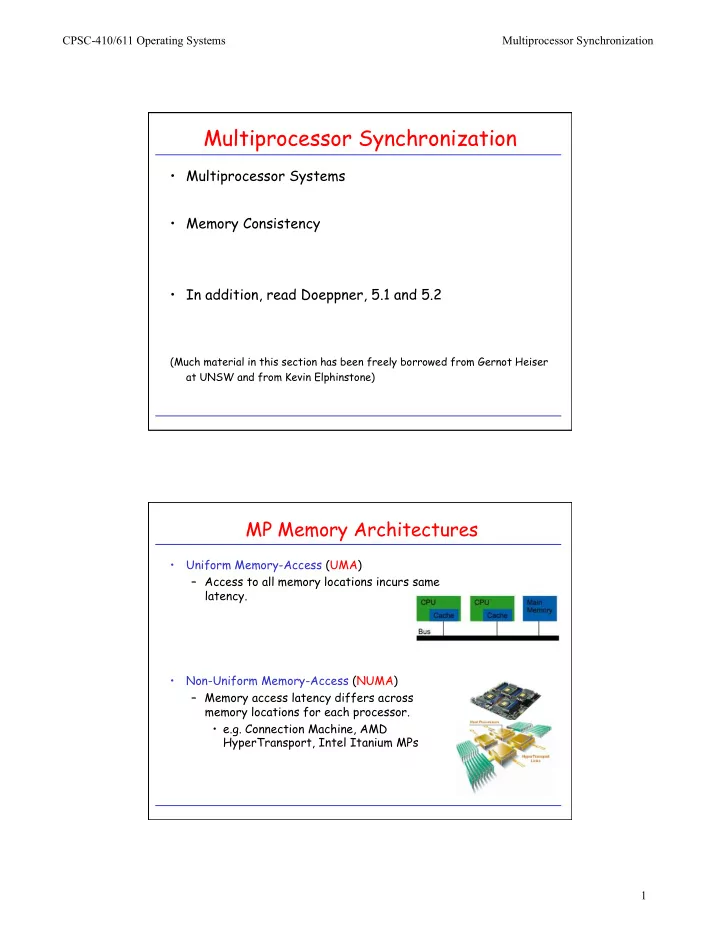

CPSC-410/611 Operating Systems Multiprocessor Synchronization Multiprocessor Synchronization • Multiprocessor Systems • Memory Consistency • In addition, read Doeppner, 5.1 and 5.2 (Much material in this section has been freely borrowed from Gernot Heiser at UNSW and from Kevin Elphinstone) MP Memory Architectures • Uniform Memory-Access (UMA) – Access to all memory locations incurs same latency. • Non-Uniform Memory-Access (NUMA) – Memory access latency differs across memory locations for each processor. • e.g. Connection Machine, AMD HyperTransport, Intel Itanium MPs 1
CPSC-410/611 Operating Systems Multiprocessor Synchronization UMA Multiprocessors: Types • “Classical” Multiprocessor – CPUs with local caches – typically connected by bus – fully separated cache hierarchy -> cache coherency problems • Chip Multiprocessor ( multicore ) – per-core L1 caches – shared lower on-chip caches – cache coherency addressed in HW • Simultaneous Multithreading – interleaved execution of several threads – fully shared cache hierarchy – no cache coherency problems Cache Coherency • What happens if one CPU writes to (cached) address and another CPU reads from the same address? • Ideally, a read produces the result of the last write to the same memory location. (“ Strict Memory Consistency”) • Typically, a hardware solution is used – snooping – for bus-based architectures – directory-based – for non bus-interconnects 2
CPSC-410/611 Operating Systems Multiprocessor Synchronization Snooping • Each cache broadcasts transactions on the bus. • Each cache monitors the bus for transactions that affect its state. • Conflicts are typically resolved using some cache coherency protocol. • Snooping can be easily extended to multi-level caches. Memory Consistency: Example • Example: End of Critical Section /* lock(mutex) */ <whatever it takes…> /* counter++ */ load r1, counter add r1, r1, 1 store r1, counter /* unlock(mutex) */ store zero, mutex • Relies on all CPUs seeing update of counter before update of mutex • Depends on assumptions about ordering of stores to memory 3
CPSC-410/611 Operating Systems Multiprocessor Synchronization Example of Strong Ordering: Sequential Ordering • Observation: Strict Consistency is impossible to implement. • Sequential Consistency : – Loads and stores execute in program order – Memory accesses of different CPUs are “sequentialised”; i.e., any valid interleaving is acceptable, but all processes must see the same sequence of memory references. • Traditionally used by many simple architectures CPU 0 CPU 1 store r1, adr1 store r1, adr2 load r2, adr2 load r2, adr1 • In this example, at least one CPU must load the other's new value. Sequential Consistency (cont) • Sequential consistency is programmer-friendly, but expensive. • Side note: Lipton & Sandbert (1988) show that improving the read performance makes write performance worse, and vice versa. • Modern HW features interfere with sequential consistency; e.g.: – write buffers to memory (aka store buffer, write- behind buffer, store pipeline) – instruction reordering by optimizing compilers – superscalar execution – pipelining 4
CPSC-410/611 Operating Systems Multiprocessor Synchronization Weaker Consistency Models: Total Store Order • Total Store Ordering (TSO) guarantees that the sequence in which store , FLUSH , and atomic load-store instructions appear in memory for a given processor is identical to the sequence in which they were issued by the processor. • Both x86 and SPARC processors support TSO. • A later load can bypass an earlier store operation. (!) • i.e., local load operations are permitted to obtain values from the write buffer before they have been committed to memory. Total Store Order (cont) • Example: CPU 0 CPU 1 store r1, adr1 store r1, adr2 load r2, adr2 load r2, adr1 • Both CPUs may read old value! • Need hardware support to force global ordering of privileged instructions, such as: – atomic swap – test & set – load-linked + store-conditional – memory barriers • For such instructions, stall pipeline and flush write buffer. 5
CPSC-410/611 Operating Systems Multiprocessor Synchronization It gets weirder: Partial Store Ordering • Partial Store Ordering (PSO) does not guarantee that the sequence in which store , FLUSH , and atomic load-store instructions appear in memory for a given processor is identical to the sequence in which they were issued by the processor. • The processor can reorder the stores so that the sequence of stores to memory is not the same as the sequence of stores issued by the CPU. • SPARC processors support PSO; x86 processors do not. • Ordering of stores is enforced by memory barrier (instruction STBAR for Sparc) : If two stores are separated by memory barrier in the issuing order of a processor, or if the instructions reference the same location, the memory order of the two instructions is the same as the issuing order. Partial Store Order (cont) • Example: load r1, counter add r1, r1, 1 store r1, counter barrier store zero, mutex • Store to mutex can “overtake” store to counter . • Need to use memory barrier to separate issuing order. • Otherwise, we have a race condition. 6
Recommend
More recommend